Cyberbullying: Impact on Youngsters and Literature Review
VerifiedAdded on 2023/04/22
|6
|1132
|107
AI Summary
This essay talks about the negative impact of cyberbullying on youngsters and the current literature review. It also suggests suitable methods to reveal the views of the youngsters about cyberbullying.
Contribute Materials
Your contribution can guide someone’s learning journey. Share your
documents today.
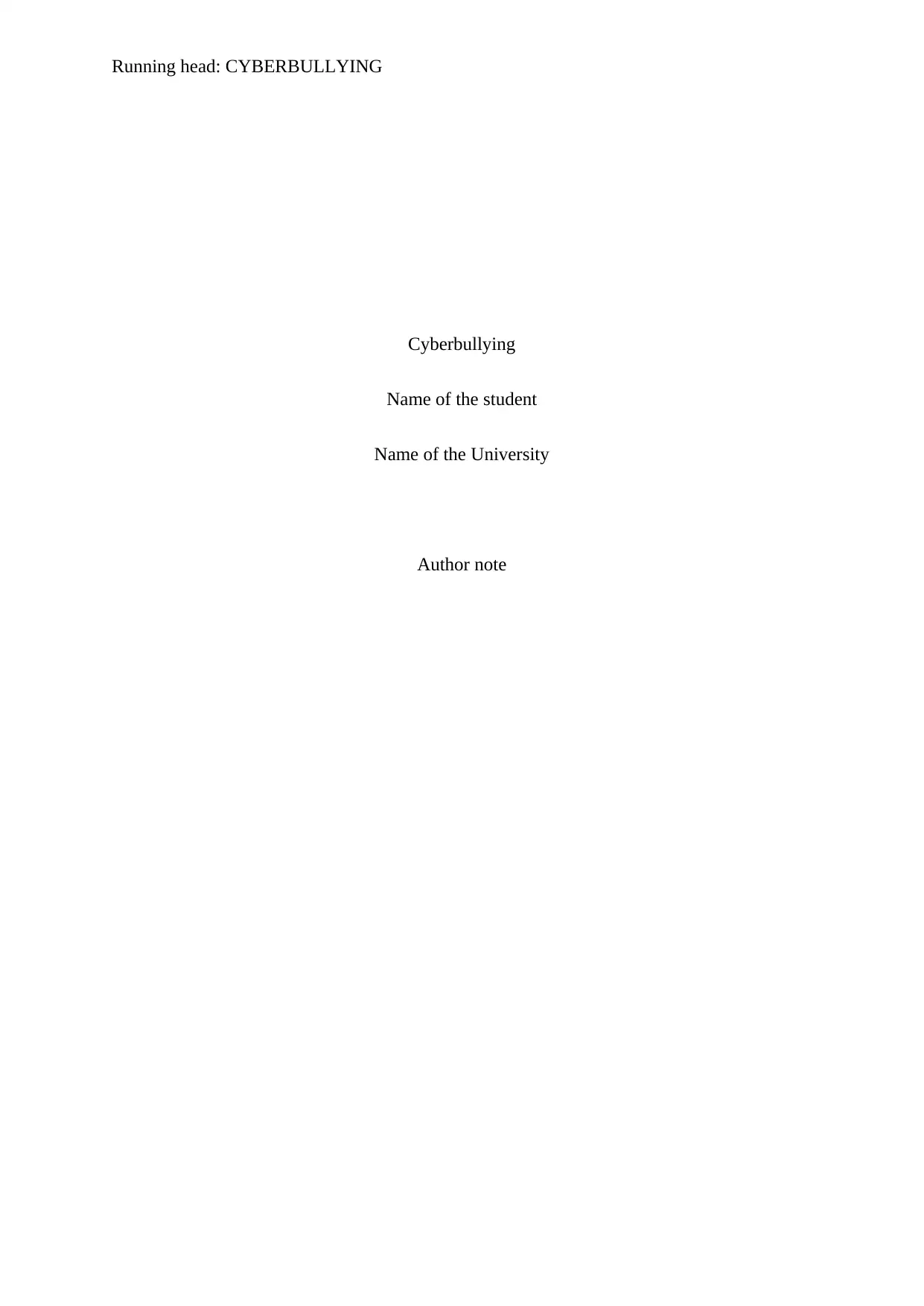
Running head: CYBERBULLYING
Cyberbullying
Name of the student
Name of the University
Author note
Cyberbullying
Name of the student
Name of the University
Author note
Secure Best Marks with AI Grader
Need help grading? Try our AI Grader for instant feedback on your assignments.
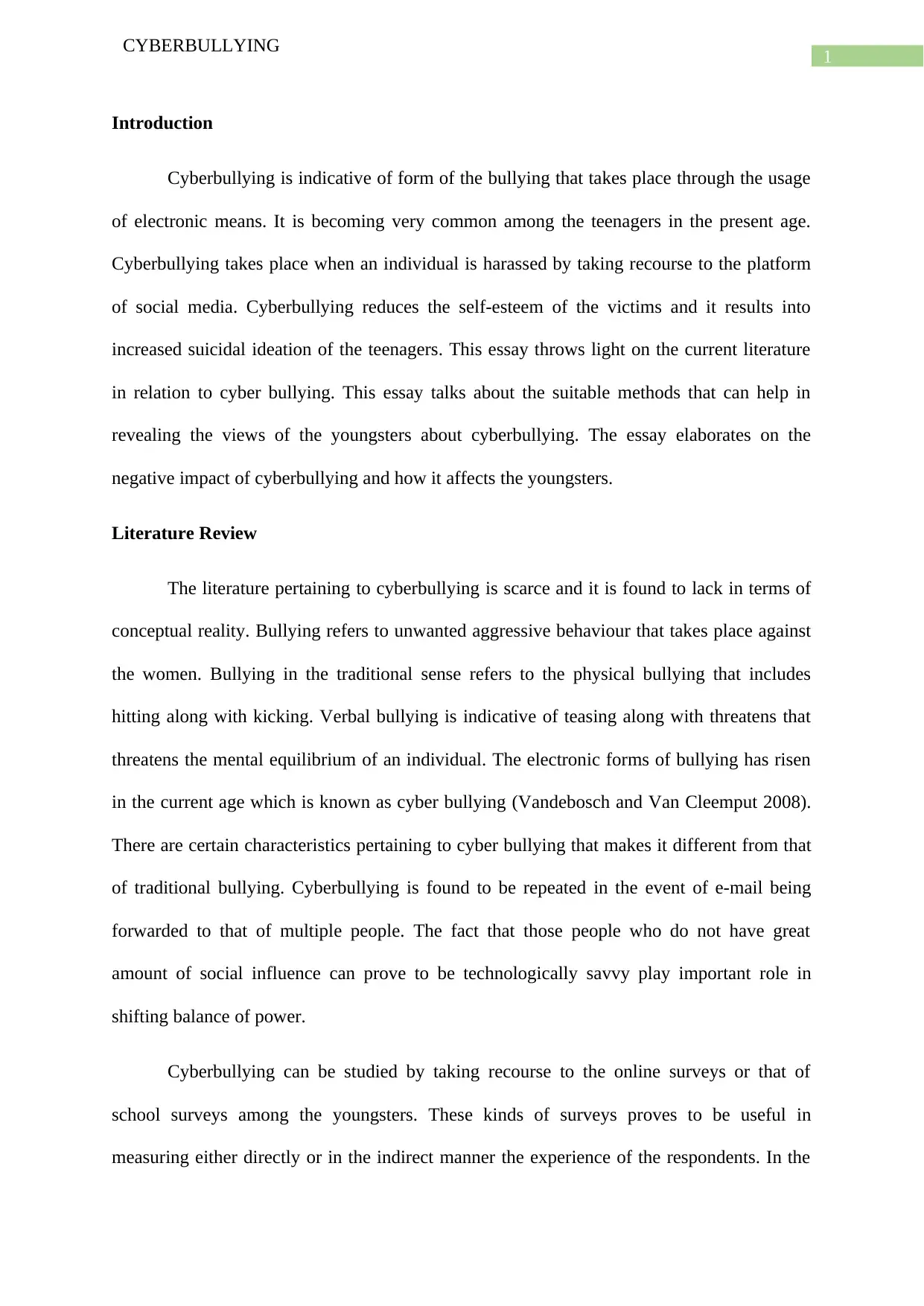
1
CYBERBULLYING
Introduction
Cyberbullying is indicative of form of the bullying that takes place through the usage
of electronic means. It is becoming very common among the teenagers in the present age.
Cyberbullying takes place when an individual is harassed by taking recourse to the platform
of social media. Cyberbullying reduces the self-esteem of the victims and it results into
increased suicidal ideation of the teenagers. This essay throws light on the current literature
in relation to cyber bullying. This essay talks about the suitable methods that can help in
revealing the views of the youngsters about cyberbullying. The essay elaborates on the
negative impact of cyberbullying and how it affects the youngsters.
Literature Review
The literature pertaining to cyberbullying is scarce and it is found to lack in terms of
conceptual reality. Bullying refers to unwanted aggressive behaviour that takes place against
the women. Bullying in the traditional sense refers to the physical bullying that includes
hitting along with kicking. Verbal bullying is indicative of teasing along with threatens that
threatens the mental equilibrium of an individual. The electronic forms of bullying has risen
in the current age which is known as cyber bullying (Vandebosch and Van Cleemput 2008).
There are certain characteristics pertaining to cyber bullying that makes it different from that
of traditional bullying. Cyberbullying is found to be repeated in the event of e-mail being
forwarded to that of multiple people. The fact that those people who do not have great
amount of social influence can prove to be technologically savvy play important role in
shifting balance of power.
Cyberbullying can be studied by taking recourse to the online surveys or that of
school surveys among the youngsters. These kinds of surveys proves to be useful in
measuring either directly or in the indirect manner the experience of the respondents. In the
CYBERBULLYING
Introduction
Cyberbullying is indicative of form of the bullying that takes place through the usage
of electronic means. It is becoming very common among the teenagers in the present age.
Cyberbullying takes place when an individual is harassed by taking recourse to the platform
of social media. Cyberbullying reduces the self-esteem of the victims and it results into
increased suicidal ideation of the teenagers. This essay throws light on the current literature
in relation to cyber bullying. This essay talks about the suitable methods that can help in
revealing the views of the youngsters about cyberbullying. The essay elaborates on the
negative impact of cyberbullying and how it affects the youngsters.
Literature Review
The literature pertaining to cyberbullying is scarce and it is found to lack in terms of
conceptual reality. Bullying refers to unwanted aggressive behaviour that takes place against
the women. Bullying in the traditional sense refers to the physical bullying that includes
hitting along with kicking. Verbal bullying is indicative of teasing along with threatens that
threatens the mental equilibrium of an individual. The electronic forms of bullying has risen
in the current age which is known as cyber bullying (Vandebosch and Van Cleemput 2008).
There are certain characteristics pertaining to cyber bullying that makes it different from that
of traditional bullying. Cyberbullying is found to be repeated in the event of e-mail being
forwarded to that of multiple people. The fact that those people who do not have great
amount of social influence can prove to be technologically savvy play important role in
shifting balance of power.
Cyberbullying can be studied by taking recourse to the online surveys or that of
school surveys among the youngsters. These kinds of surveys proves to be useful in
measuring either directly or in the indirect manner the experience of the respondents. In the
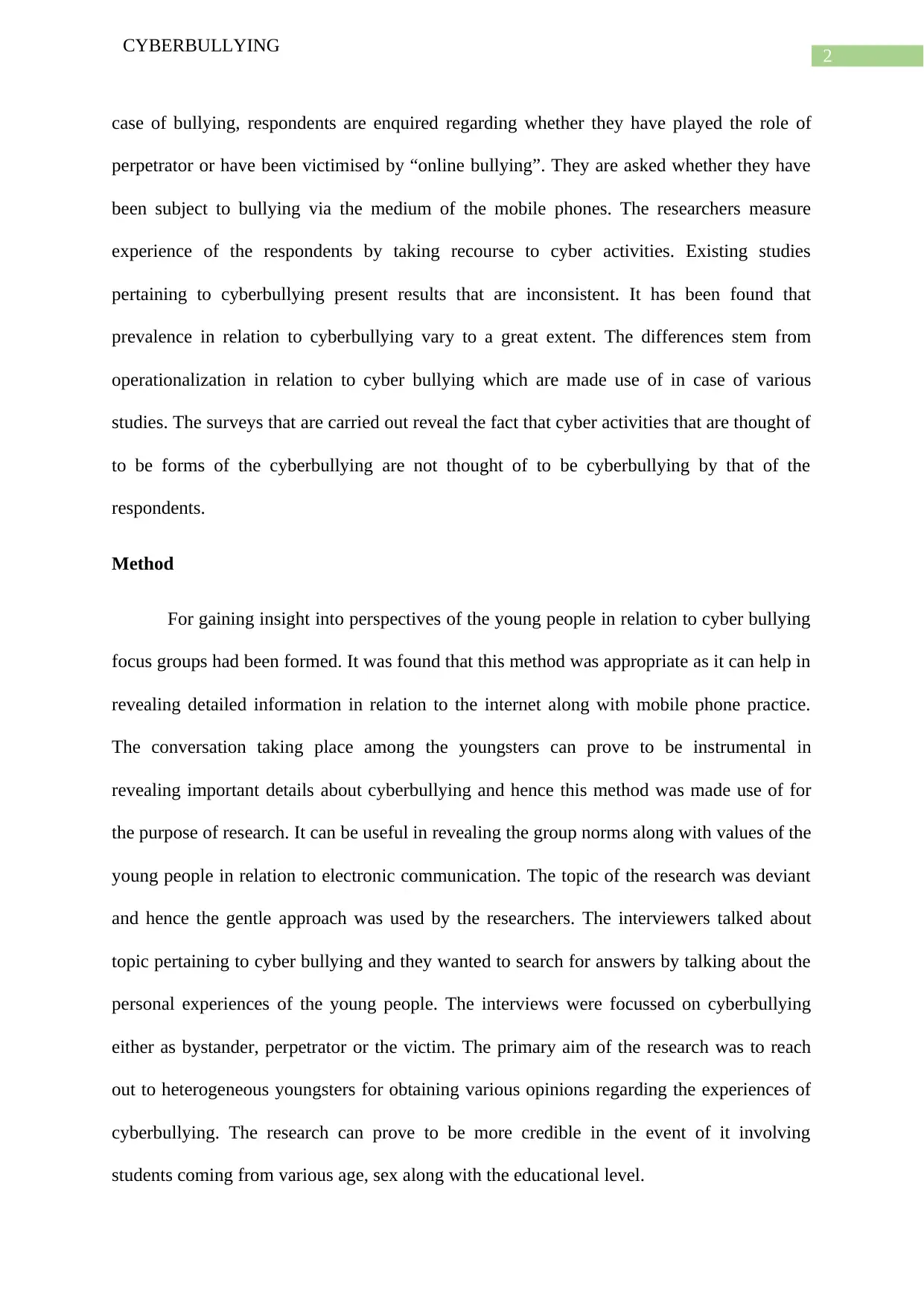
2
CYBERBULLYING
case of bullying, respondents are enquired regarding whether they have played the role of
perpetrator or have been victimised by “online bullying”. They are asked whether they have
been subject to bullying via the medium of the mobile phones. The researchers measure
experience of the respondents by taking recourse to cyber activities. Existing studies
pertaining to cyberbullying present results that are inconsistent. It has been found that
prevalence in relation to cyberbullying vary to a great extent. The differences stem from
operationalization in relation to cyber bullying which are made use of in case of various
studies. The surveys that are carried out reveal the fact that cyber activities that are thought of
to be forms of the cyberbullying are not thought of to be cyberbullying by that of the
respondents.
Method
For gaining insight into perspectives of the young people in relation to cyber bullying
focus groups had been formed. It was found that this method was appropriate as it can help in
revealing detailed information in relation to the internet along with mobile phone practice.
The conversation taking place among the youngsters can prove to be instrumental in
revealing important details about cyberbullying and hence this method was made use of for
the purpose of research. It can be useful in revealing the group norms along with values of the
young people in relation to electronic communication. The topic of the research was deviant
and hence the gentle approach was used by the researchers. The interviewers talked about
topic pertaining to cyber bullying and they wanted to search for answers by talking about the
personal experiences of the young people. The interviews were focussed on cyberbullying
either as bystander, perpetrator or the victim. The primary aim of the research was to reach
out to heterogeneous youngsters for obtaining various opinions regarding the experiences of
cyberbullying. The research can prove to be more credible in the event of it involving
students coming from various age, sex along with the educational level.
CYBERBULLYING
case of bullying, respondents are enquired regarding whether they have played the role of
perpetrator or have been victimised by “online bullying”. They are asked whether they have
been subject to bullying via the medium of the mobile phones. The researchers measure
experience of the respondents by taking recourse to cyber activities. Existing studies
pertaining to cyberbullying present results that are inconsistent. It has been found that
prevalence in relation to cyberbullying vary to a great extent. The differences stem from
operationalization in relation to cyber bullying which are made use of in case of various
studies. The surveys that are carried out reveal the fact that cyber activities that are thought of
to be forms of the cyberbullying are not thought of to be cyberbullying by that of the
respondents.
Method
For gaining insight into perspectives of the young people in relation to cyber bullying
focus groups had been formed. It was found that this method was appropriate as it can help in
revealing detailed information in relation to the internet along with mobile phone practice.
The conversation taking place among the youngsters can prove to be instrumental in
revealing important details about cyberbullying and hence this method was made use of for
the purpose of research. It can be useful in revealing the group norms along with values of the
young people in relation to electronic communication. The topic of the research was deviant
and hence the gentle approach was used by the researchers. The interviewers talked about
topic pertaining to cyber bullying and they wanted to search for answers by talking about the
personal experiences of the young people. The interviews were focussed on cyberbullying
either as bystander, perpetrator or the victim. The primary aim of the research was to reach
out to heterogeneous youngsters for obtaining various opinions regarding the experiences of
cyberbullying. The research can prove to be more credible in the event of it involving
students coming from various age, sex along with the educational level.
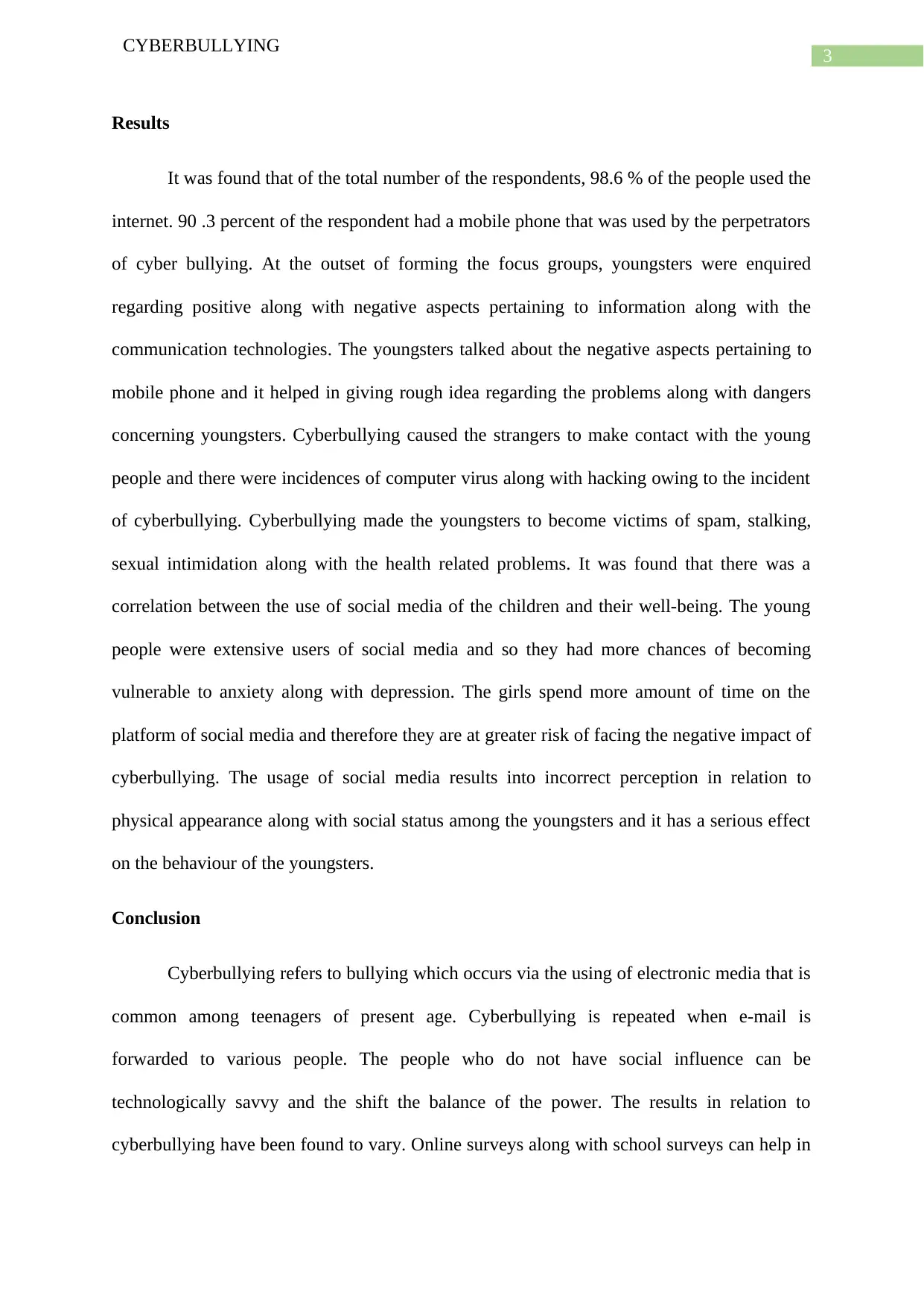
3
CYBERBULLYING
Results
It was found that of the total number of the respondents, 98.6 % of the people used the
internet. 90 .3 percent of the respondent had a mobile phone that was used by the perpetrators
of cyber bullying. At the outset of forming the focus groups, youngsters were enquired
regarding positive along with negative aspects pertaining to information along with the
communication technologies. The youngsters talked about the negative aspects pertaining to
mobile phone and it helped in giving rough idea regarding the problems along with dangers
concerning youngsters. Cyberbullying caused the strangers to make contact with the young
people and there were incidences of computer virus along with hacking owing to the incident
of cyberbullying. Cyberbullying made the youngsters to become victims of spam, stalking,
sexual intimidation along with the health related problems. It was found that there was a
correlation between the use of social media of the children and their well-being. The young
people were extensive users of social media and so they had more chances of becoming
vulnerable to anxiety along with depression. The girls spend more amount of time on the
platform of social media and therefore they are at greater risk of facing the negative impact of
cyberbullying. The usage of social media results into incorrect perception in relation to
physical appearance along with social status among the youngsters and it has a serious effect
on the behaviour of the youngsters.
Conclusion
Cyberbullying refers to bullying which occurs via the using of electronic media that is
common among teenagers of present age. Cyberbullying is repeated when e-mail is
forwarded to various people. The people who do not have social influence can be
technologically savvy and the shift the balance of the power. The results in relation to
cyberbullying have been found to vary. Online surveys along with school surveys can help in
CYBERBULLYING
Results
It was found that of the total number of the respondents, 98.6 % of the people used the
internet. 90 .3 percent of the respondent had a mobile phone that was used by the perpetrators
of cyber bullying. At the outset of forming the focus groups, youngsters were enquired
regarding positive along with negative aspects pertaining to information along with the
communication technologies. The youngsters talked about the negative aspects pertaining to
mobile phone and it helped in giving rough idea regarding the problems along with dangers
concerning youngsters. Cyberbullying caused the strangers to make contact with the young
people and there were incidences of computer virus along with hacking owing to the incident
of cyberbullying. Cyberbullying made the youngsters to become victims of spam, stalking,
sexual intimidation along with the health related problems. It was found that there was a
correlation between the use of social media of the children and their well-being. The young
people were extensive users of social media and so they had more chances of becoming
vulnerable to anxiety along with depression. The girls spend more amount of time on the
platform of social media and therefore they are at greater risk of facing the negative impact of
cyberbullying. The usage of social media results into incorrect perception in relation to
physical appearance along with social status among the youngsters and it has a serious effect
on the behaviour of the youngsters.
Conclusion
Cyberbullying refers to bullying which occurs via the using of electronic media that is
common among teenagers of present age. Cyberbullying is repeated when e-mail is
forwarded to various people. The people who do not have social influence can be
technologically savvy and the shift the balance of the power. The results in relation to
cyberbullying have been found to vary. Online surveys along with school surveys can help in
Secure Best Marks with AI Grader
Need help grading? Try our AI Grader for instant feedback on your assignments.

4
CYBERBULLYING
studying the incidence of cyberbullying in the present age and they help in revealing
experience of respondents. Focus groups can help in revealing important information about
the opinion of young people. It can bring out important information about different facets in
relation to cyberbullying in society. Social media usage was more prevalent among girls and
they have more chances of becoming the victim of cyberbullying.
CYBERBULLYING
studying the incidence of cyberbullying in the present age and they help in revealing
experience of respondents. Focus groups can help in revealing important information about
the opinion of young people. It can bring out important information about different facets in
relation to cyberbullying in society. Social media usage was more prevalent among girls and
they have more chances of becoming the victim of cyberbullying.
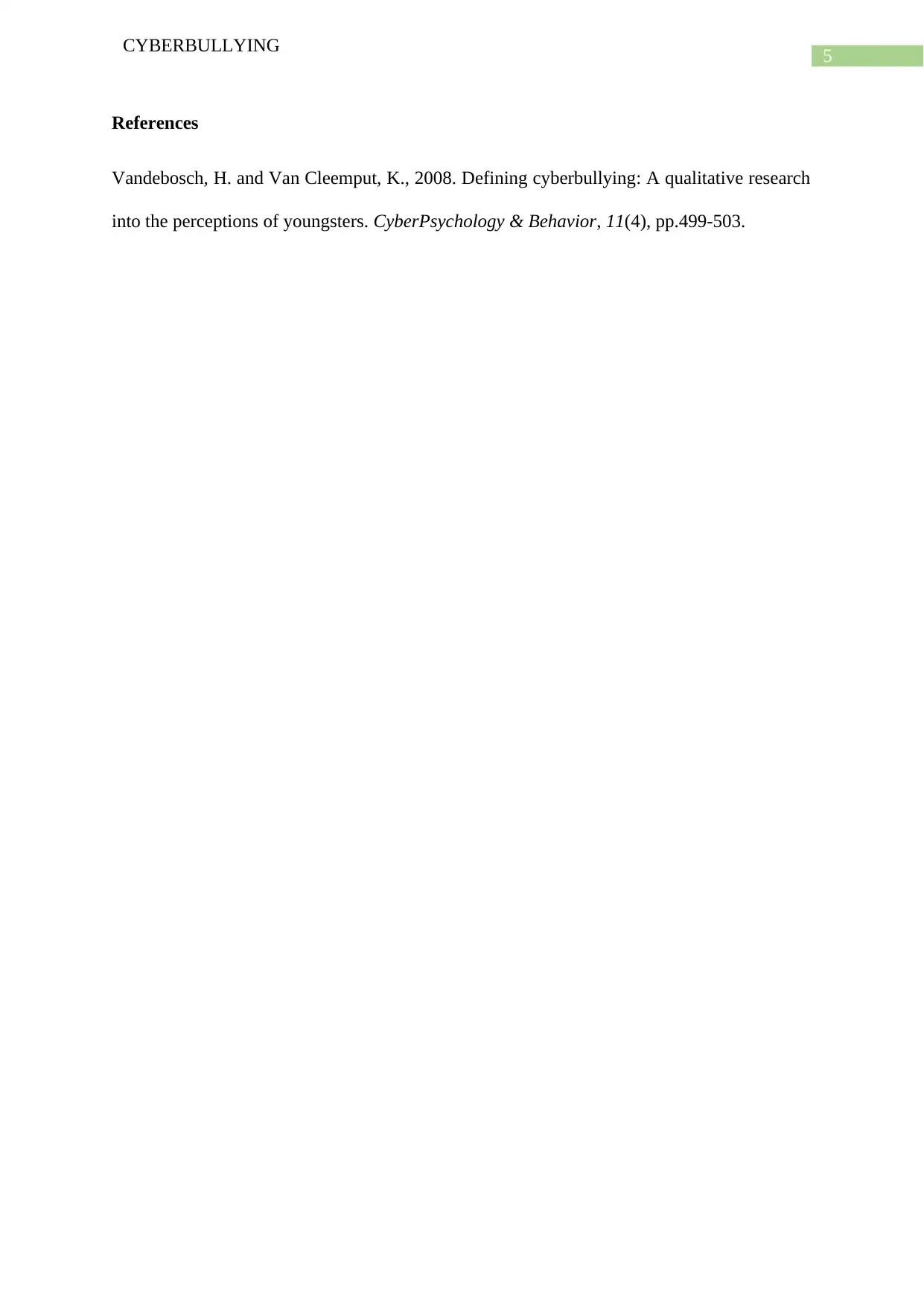
5
CYBERBULLYING
References
Vandebosch, H. and Van Cleemput, K., 2008. Defining cyberbullying: A qualitative research
into the perceptions of youngsters. CyberPsychology & Behavior, 11(4), pp.499-503.
CYBERBULLYING
References
Vandebosch, H. and Van Cleemput, K., 2008. Defining cyberbullying: A qualitative research
into the perceptions of youngsters. CyberPsychology & Behavior, 11(4), pp.499-503.
1 out of 6
Related Documents
Your All-in-One AI-Powered Toolkit for Academic Success.
+13062052269
info@desklib.com
Available 24*7 on WhatsApp / Email
![[object Object]](/_next/static/media/star-bottom.7253800d.svg)
Unlock your academic potential
© 2024 | Zucol Services PVT LTD | All rights reserved.




